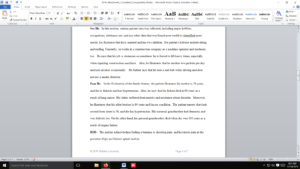Healthcare Research and Quality
Photo Credit: University of Virginia. (n.d.). Lumbar Spine Anatomy [Photograph]. Retrieved from http://www.med-ed.virginia.
edu/courses/rad/ext/5lumbar/ 01anatomy.html. Used with permission of University of Virginia.
A 42-year-old male reports pain in his lower back for the past month. The pain sometimes radiates to his left leg. In determining the cause of the back pain, based on your knowledge of anatomy, what nerve roots might be involved? How would you test for each of them? What other symptoms need to be explored? What are your differential diagnoses for acute low back pain? Consider the possible origins using the Agency for Healthcare Research and Quality (AHRQ) guidelines as a framework. What physical examination will you perform? What special maneuvers will you perform
With regard to the case study you were assigned:
-
-
- Review this week’s Learning Resources, and consider the insights they provide about the case study.
- Consider what history would be necessary to collect from the patient in the case study you were assigned.
- Consider what physical exams and diagnostic tests would be appropriate to gather more information about the patient’s condition. How would the results be used to make a diagnosis?
- Identify at least five possible conditions that may be considered in a differential diagnosis for the patient.
-
Post an episodic/focused note about the patient in the case study to which you were assigned using the episodic/focused note template provided in the Week 5 resources. Provide evidence from the literature to support diagnostic tests that would be appropriate for each case. List five different possible conditions for the patient’s differential diagnosis, and justify why you selected each.
Requirements: 3 pages
Please,follow the posted instructions carefully.This assignment will come with 5 most recent APA referrences,
Please use this template for this assignment.Thanks.
Answer preview
Gait problem. The patient’s walking style slightly changes due to back pain.
Diagnostic results: Include any labs, x-rays, or other diagnostics that are needed to develop the differential diagnoses (support with evidence and guidelines)
Various diagnostic testing was implemented to evaluate the patient’s health problem. One of the tests conducted is the straight leg raise (SLR) test. In this test, the patient was asked to lie down on his back and lift his left with the other leg flat at the knee (Hartvigsen, Hancock, Kongsted, Louw, Ferreira, Genevay, & Woolf, 2018). He reported pain in his left leg while lifting it. Also, a slump test was conducted where the patient was asked to sit upright with his hands behind the back. The patient bends forward at the hip. While his neck is bent with the chin touching the chest and left leg extended to a degree possible, the patient reported pain in his back. A magnetic resonance imaging (MRI) was used to visualize the sciatic nerve on the left leg, surrounding soft tissues, and facet joint capsules. An inflammation on the facet joints, herniated discs were detected. Also, a discogram was used in determining the abnormalities in a disc like herniation.
[1318 Words]

Healthcare Research and Quality

